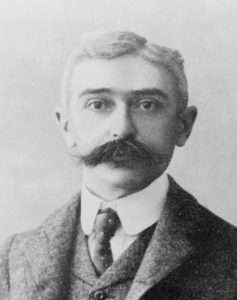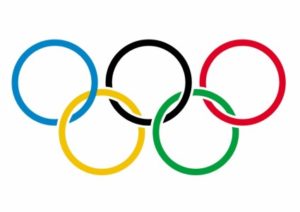THE OLYMPIC GAMES – A BRIEF HISTORY
The Ancient Olympics (776 BCE – 5th Century CE)
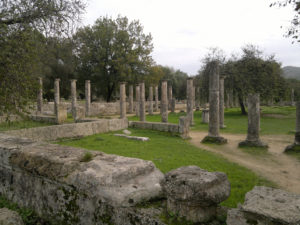 Ancient Olympia (Photo by: John Karakatsanis)
Ancient Olympia (Photo by: John Karakatsanis)
Origins
During the ancient period many Greek city-states, and others, had their own competitions, but four of them were more prestigious. These four – Nemean, Pythian, Isthmian and Olympic – formed a periodos (meaning cycle). An athlete who won all these was indeed a master of his sport. The Nemean and Isthmian were biennial while the other two were quadrennial. Where the habit of having a contest every four years, as the Olympic, comes from is under debate, but the earliest myth of the Olympic origin is told by the Greek historian Pausanias. There the dactyl Herakles, not to be confused with the son of Zeus, and four of his brothers, raced at Olympia to amuse the newborn king of the gods (Zeus). Herakles and the four brothers thereby explain the four year (inclusive) interval.
The games were open to all free-born Greeks. This spread to later include the Greek colonies in the Roman Empire and elsewhere. There was also a stipulation that the contester should be a young man even though there are records of women participating in the competitions. The games were held in the summer and at the beginning only lasted for one or two days. As the program became more and more congested, the period was expanded to five or six days. The games had major political significance as the states tried to assert dominance over others using the games as a front; and announce alliances during the competitions. Winning an event reflected positively on the winners home state. A general truce was upheld during the games.
The Ancient Olympics at Olympia continued for more than 1 000 years until the games were discontinued in the 5th century CE. The reason was in part economical in that most city-states saw their revenue decline and could not pay for their games, but also that the mentality of people changed during antiquity. The training for glory and the possible fame was seen as being a sign of vanity.
The place of Olympia was not a city but an area surrounded by a wall. It contained temples and areas for sporting events – such as a running track and a track for horseracing (hippodrome). After the games were discontinued in the early 5th century the area suffered several natural disasters, such as earthquakes and floods, and was buried beneath a four meter layer of silt. Olympia was lost until 1776 when Richard Chandler, an English antiquarian, discovered the site. It was fully excavated a hundred years later by Ernst Curtius and his Prussian expedition.
Sports and notable athletes
The sports in the Ancient Olympics can be divided into four categories. These are running, pentathlon, combat sports and horse racing. Besides this there were musical competitions for heralds and trumpeters.
Running was contested in four events in Olympia. The stadion run, at Olympia roughly 192m, was the shortest sprint distance. Two stadia runs, called diaulos, was the other sprint distance. The longest running race was the dolichos. The length of this varied, but 20 stadia has been mentioned, about 3,6 to 3,9km. One special running event was the race in armor. In this the performer had to wear a helmet, greaves and a shield and run the diaulos.
The pentathlon consisted of the throwing of javelin and discus, standing long jump, running and wrestling. Javelin was performed more or less as today while discus probably was executed without turning around one’s own axis. The long jump was performed while holding weights of about 1,5kg in each hand and making five jumps in a row accompanied by flute music! The latter was used to ease coordination. The running race was 192m long and run naked. The wrestling match was won when the opponent had touched the ground three times. This upright wrestling had some ground rules. Blows were not permitted, nor were biting or grabbing the opponents genitals.
The combat sports consisted of three events: the wrestling, the boxing and the pankration. The form of wrestling contested in Olympia is described above. The boxing gloves used had hard leather straps to make the blows more efficient and the inside was patted with wool. The rules forbade grabbing an opponent, punching the genitals and extra reinforcements on the gloves. The tournaments were divided into age categories rather than weight and the matches ended when one of the opponents submitted. Pankration was a combination of wrestling and boxing in which all holds of the former and all blows of the latter was permitted. The only things forbidden were biting, eye-gouging and attacking the genitals. In the ground pankration, the form mostly used in Olympia, one could only lose by submitting to the opponent. This could result in deaths, which it did. At the time the winner of the pankration was considered the ultimate in strength, technique and combat skills.
The most prestigious event was the horse racing. The keeping and travelling with horses where only for the rich. There where three kinds of races: four-chariot (14km race), two-chariot (8km) and horse with rider (1,2km). The winner of the first mentioned race received the highest honor. The hippodrome served as the arena for the sport and it had to be sufficiently wide for the many contestants. Accidents did occur when the chariots turned at the end of the track. In Olympia there was an elaborate starting mechanism to make sure the chariots started at the same time.
There are several personalities that excelled in the ancient Olympics. King Philip of Macedonia won several horse races; Marcus Aurelius Asklepiades won pankration in all the major games (see above). Euthymos of Lokro won three boxing titles at Olympia and Theagenes won two Olympic titles. The latter was so proud of his victories that he named his son Disolympios (“double Olympic champion”).
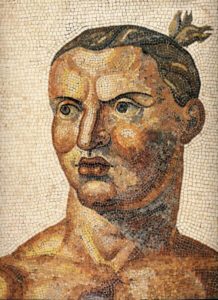 Marcus Aurelius Asklepiades. (Picture from: ancientolympics.art.kuleuven.be).
Marcus Aurelius Asklepiades. (Picture from: ancientolympics.art.kuleuven.be).
In Olympia the winner won an olive crown but at other games cash prizes were awarded and crowns of solid gold was not unheard of.
Modern Olympics (1896-present)
Origins
Several sports festivals across Europe in the 19th century had taken their name from the Ancient Olympics. An Olympic games held in Athens in 1870 attracted 30 000 spectators. The idea was taken up by the future president of the International Olympic Committee – Pierre de Coubertin. He took inspiration also from the Englishman William Penny Brooks and his Wenlock Olympian Games in Shropshire, Great Britain. The idea to hold an international multi-sporting event named the Olympics had been born.
Eleven countries were present at a meeting organized by de Coubertin in 1894 and it was decided to host the first games in 1896. This was officially endorsed by the Greek king George in June of the same year. However, that the place should be Athens was in no way clear. De Coubertin first suggested Paris and wanted to move the games to the year 1900 and the World’s Fair. Others put forth London as a suggestion. Vikelas, the Greek representative at the meeting, had a brief chat with de Coubertin and they agreed on Athens. The congress then unanimously decided on the Greek capital as this had been the site of the original Olympics.
The early modern Olympics were in a way influenced by what the originators at the time thought the ancient Olympics were about. These features included amateurism, the honor of participating and not receiving cash for winning. However, these were not present to any large extent in the ancient Olympics. None, or very few, of the athletes there were amateurs, except perhaps in the old East European sense of the word where the athletes held, for example, a military position, and simultaneously were paid by the state. Baron de Coubertin’s word of “it is more important to have fought well than to have won” would have sounded false in ancient Greece. The object was to win the event, not just to participate. This is underlined by the fact that only the winner received a prize and true glory. The feature about cash prizes was correct if we talk about the games at Olympia but untrue at many other places. It is also worth noting that Greco-Roman wrestling – one of the forms of wrestling at the modern Olympics – hasn’t much to do with the ancient form at Olympia. Ancient wrestling in modern terms, would, if anything, rightly be called freestyle…
Winter Olympics
The Nordic Games in winter sports was held for the first time in 1901 and continuously up to 1926. The Swede Viktor Balck and the Italian Eugenio Brunetta d’Usseaux tried to incorporate winter sports to the Olympics of 1908 and 1912 but they were unsuccessful but for figure skating in 1908. After the First World War, winter sports were part of the 1920 summer games in Antwerp – figure skating and ice hockey. Four years later the International Winter Sports Week was held separately from the summer Olympics. The week was an instant success and the year after it was retroactively named the 1st winter Olympics. After the games in Albertville and Barcelona in 1992 it was decided to hold the Winter- and Summer- Olympics on different occasions.
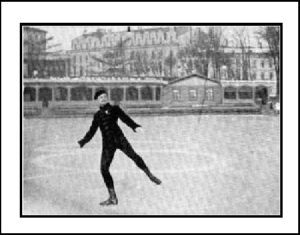 Russian Nikolai Panin won a figure skating gold in 1908. (Picture from allrus.me).
Russian Nikolai Panin won a figure skating gold in 1908. (Picture from allrus.me).
Politics
The Olympics have been, and still are, heavily politicized. Boycotts for political reasons were rampant, especially during the cold war. Other significant political issues have also affected the games. Here’s a brief list, which in no way is intended to be complete:
1904: In St. Louis, the so called Anthropological Games were held in proximity to the regular games. In these indigenous peoples and members of different “tribes” competed in various sports. Nowadays these competitions would have been considered racist as the competitors was referred to as “savage” and of lesser worth by the organizers. A spectacle for the, mainly, white onlookers to enjoy (?), one might say.
1920: Hungary, Germany, Turkey, Austria and Bulgaria were banned from the Antwerp games as they had been members of the Central Powers in World War 1. Germanys ban lasted over the 1924 games as well.
1936: In the Berlin games in Nazi Germany Jews and Romanis were excluded from competing in the German squad. The Americans pulled their only Jews off their 4x100m relay team. This is the only time that both the Winter- and Summer- games have been held in the same country in the same year.
1948: In London Germany and Japan were not allowed to participate as punishment for World War 2.
1952: In the winter games in Oslo the Norwegian speed skater Finn Hodt was not allowed to participate because of his Nazi collaboration during the war.
1968: Black sprinters Tommie Smith and John Carlos gave the “Black Power salute” on the podium by raising a black-gloved fist in the air as their national anthem was played during the Mexico City games.
1972 The “Munich massacre” overshadowed the games. In all 17 people were killed when the militant Palestinian group “Black September” took 11 members of the Israeli Olympic team hostage.
1976: Many of the African nations boycotted the games in Montreal as the IOC refused to ban New Zealand after their rugby team had toured in Apartheid South Africa.
1980: Most of the western countries boycotted the games in Moscow in protest of the Soviet invasion of Afghanistan.
 The Moscow Olympics mascot Mischa. (Picture from gilderlehrman.org)
The Moscow Olympics mascot Mischa. (Picture from gilderlehrman.org)
1984: The Warsaw pact, except Romania, and their supporting countries refused to travel to Los Angeles in response to the western boycott four years earlier.
1996: A pipe bomb explosion in the Centennial Olympic Park of Atlanta killed two people and wounded 111.
2016: The international athletics federation, IAAF, banned Russia from the competitions because of major deficiencies in their anti-doping work.
Amateurism
The Olympic concept that the competitor should be an amateur was present from the start. Performing the sport as recreation was essential. This rule was strictly enforced and there have been cases where athletes were disqualified from the Olympics for accepting money. Jim Thorpe was stripped of his decathlon gold at the 1912 Olympics because he had accepted money for playing baseball. Gunder Hägg – the formidable Swedish middle distance runner – was disqualified for life for breaches against the amateur status. He had been given prize money in exchange for running during World War 2.
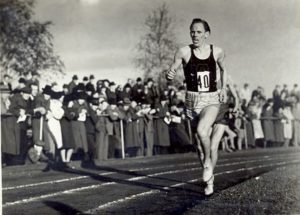 Gunder Hägg. (Picture from bygdeband.se)
Gunder Hägg. (Picture from bygdeband.se)
Two major events began the questioning of amateurism and its enforcement in the Olympics. The first of these was the introduction of the Eastern bloc countries in the 1950: s. There the athletes held nominal positions as students, soldiers and so on, but still trained full time and received heavy financial backing by the state. No division of amateur and professional existed there as it did elsewhere. The phrase “state amateurs” was coined. However, they were considered amateurs in the eyes of the IOC and were thus free to participate at the games. The other thing was the rise of professionals among the Olympic sports. First and foremost this can be said to be connected to athletics. In the 1970: s many of the bigger names was contracted to perform in galas and for this they received considerable amounts of money. According to the amateur ruling they should have been banned from Olympic participation. Yet, they were not.
One can say that by the 1990: s the concept of amateurism was well and truly abandoned in the Olympic movement. In the team sports, such as ice hockey, football and handball, professional players participated, as well as in athletics. The American Dream Team in basketball shattered the amateur dream once and for all when millionaire ball players made up the USA team in the 1992 Barcelona Olympics. Nowadays there are only two sports where professionals are not allowed – boxing and wrestling. But that is mainly because the amateur form of those sports differs from the professional one. In the first mentioned professionals are allowed to compete, but all the various professional boxing organizations have stated that any professional champion competing in the Olympics will lose their title! Football (soccer) have another ruling – in the men’s tournament – that bars the best players from attending but this is all to do with FIFA – the World Footballing body – not wanting their sport to be just a part of the whole. However, overall the best and brightest athletes perform at the Olympics – the way it should be!
Cheating
Doping
Doping as such did not exist in the ancient world as no potion or remedy was banned. Only black magic could not be used. In the modern games doping is an ever frequent occurrence. The honor, glory and subsequent benefits of winning make some succumb to performance enhancing drugs, or other illegal means, to assure (?) success.
The first notable instance of a performer using drugs to better his performance was in the 1904 Olympics. The marathon winner, Thomas Hicks of the USA, was injected with strychnine and also given a dose of brandy. By today’s standards he would have been disqualified but the first ban on performance enhancing drugs did not come into the Olympics until the winter games of 1968. The first man to lose a medal under the new ruling was the Swede Hans-Gunnar Liljenwall in the modern pentathlon team event. He was disqualified for using ethanol. Liljenwall had taken a few beers to steady his nerves before the shooting event. Alcohol as such was not forbidden but his blood alcohol level was too high. Rick DeMont of the USA was the first person to lose a gold medal, when he was stripped of his 400 m freestyle title at the 1972 Olympics in Munich.
Up to date there are more than 50 occurrences of summer medalists losing their medals while more than 10 winter athletes have suffered the same fate. Three persons have lost multiple gold medals.
Other means
There have been other means of cheating in the Olympics than the use of drugs. The first man over the finish line in the 1904 marathon was Fred Lorz. But he was disqualified after it was discovered that he had covered most of the course by car!
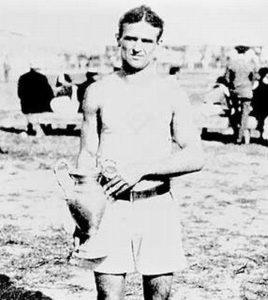 Fred Lorz. (Picture from complex.com).
Fred Lorz. (Picture from complex.com).
The modern pentathlete Boris Onisjenko did in 1976 construct a fencing weapon in which he could himself register a hit at will! This was discovered when the opposing contester remarked that Onisjenko had got a point without hitting anything…
During the 2012 Olympics eight badminton players were disqualified from the tournament for attempting to lose on purpose. By doing that they believed they would get a weaker opponent in the next round.
Symbols
There are a few symbols connected with the Olympics. One can name for example the fire, the torch, the medals, the marathon, the hymn and the rings.
In the ancient Olympics a fire burned throughout the competition. Fire was thought to have been stolen from Zeus by Prometheus. And because the Olympics were a celebration to the gods, and Zeus in particular, fires were lit at his temple and Hera’s. The ignition of the modern flame is done where the temple of Hera used to stand in Olympia. The fire custom was taken up in 1928 in the modern era when a flame was lit in the Marathon tower in the Amsterdam Olympics.
A torch relay was run during the ancient Greek games, though not the Olympian one. The object was to run a course and then hand over the torch to the next team member. The team that crossed the finish line first with the fire still burning won the race. In modern days the transporting of a torch to the site of the games was taken up in 1936 in Berlin. 3 331 runners transported the flame 3 187 km to its final destination. Usually runners carry the flame but boat and airplane, as well as riders on horseback, have also been used.
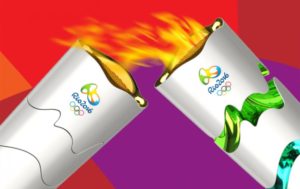 Torch symbol used at the Rio 2016 Olympics website.
Torch symbol used at the Rio 2016 Olympics website.
The first price in the ancient Olympics was an olive wreath (kotinos) in the form of a circle or a horse-shoe. No other competitor than the winner received a price at the games. During the first modern Olympics in 1896 the winner received a silver medal and an olive branch while the 2nd placed got a copper or bronze medal and a laurel wreath. The introduction of gold, silver and bronze for the first three was for the 1904 games in St. Louis. The design and construction of the medals have varied a lot over the years, from 33 to 107mm in diameter and 21 to 576g in weight. The gold medals consist of at least .925 grade silver covered with six grams of pure gold, the silver medal is the same without the gold covering and the bronze medal is made of copper with some zinc and tin mixed in. The use of a podium, to hand out the medals in close proximity to the achievement, was not introduced until 1932 and the first Los Angeles games. Before that the medals were awarded at the closing ceremony of each Olympics.
The name marathon emanates from the legend of Pheidippides. It is said that he ran the entire way from the battlefield at Marathon to Athens and upon arrival exclaimed “νενικηκαμεν” (nenikekamen) (“We won”) before he collapsed and died. Although the battle of Marathon actually took place, the legend is very much in doubt. The first known story of the “Marathon runner” was written several hundred years after the supposed events. Furthermore, ancient historians do not agree whether or not a runner actually was sent to Athens or if so, what his name was. Nevertheless, at the modern Olympics in Greece in 1896 the idea of a popularizing event featuring ancient history was heavily supported. The length of the course was about 40km, which roughly is the distance between Athens and Marathon. 42 195m is the Marathon of today and that was the course length of the 1908 London Olympics. From 1924 and onwards this is the official Marathon race distance.
The Olympic hymn was first performed for the opening of the 1896 games. The music was written by Spyridon Samaras with words by Kostis Palamas. However, the words sung in English differ greatly from the translated version of the original Greek lyrics. The focus on brotherhood, fellowship and the Olympic flame is much more pronounced in the sung translated version. The anthem was not made an official Olympic hymn until the Olympics of 1960. Before that each host composed their own anthem.
The emblem of the Olympic rings was designed by Pierre de Coubertin, the father of the modern Olympics, in time for the 1912 games in Stockholm. The five rings of blue, yellow, black, green and red represented, according to de Coubertin, the colors of the flags of the countries that competed then. Nowadays the emblem is said to represent the five regions of the world and the interlocking of them is the meeting of the athletes at the games.
The Olympic spectacle
Nations and cities around the world are clamoring to host the Olympics even though the cost of the games is staggering. Montreal, for example, faced debts for 30 years after hosting the games in 1976. But the Olympics are a spectacle, an event of huge proportions. They are followed by billions all over the globe from the stands, the Internet, TV and radio. As a spectator one can perceive all the action on sight or from ones comfortable couch. It is also a great place for lesser known sports to be recognized – for a couple of years – to others than those who perform them. Arguably the concept of sport and its values is epitomized in the Olympics. The fastest runner, swimmer or cyclist, the highest jumping athlete, the most hard hitting boxer, the most prolific taekwondo or judo performer, the best handball, football or ice hockey player, the most graceful gymnast or figure skater, the strongest weight lifter, the fastest rower or canoer or the most skillful fencer – to name but a few of the sports represented – all do they yearn to win that gold medal that will give them eternal fame and a place in the history books!

